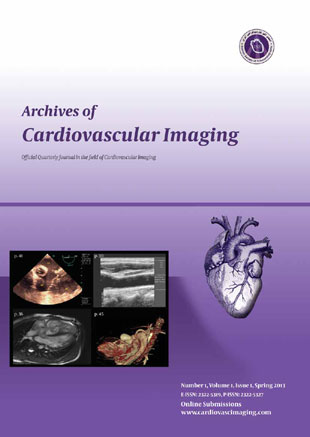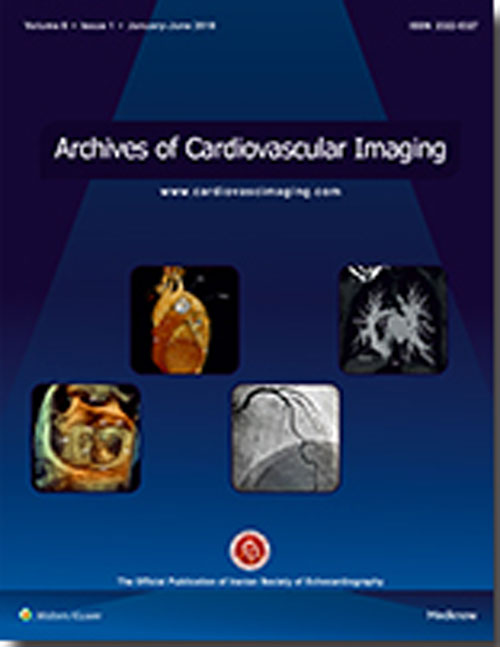فهرست مطالب

Archives Of Cardiovascular Imaging
Volume:1 Issue: 1, Aug 2013
- 52 صفحه،
- تاریخ انتشار: 1392/06/03
- تعداد عناوین: 13
-
Page 2BackgroundRecently, assessment of the atrial motion and deformation indices obtained via Doppler myocardial imaging (DMI) has been proposed as a new method of exploring the atrial function.ObjectiveOur aim was to assess the right atrial (RA) regional function using myocardial velocities, strain, and strain rate imaging (SRI) and compare it with the function of the inter-atrial septum (IAS) and left atrial (LA) lateral wall in healthy young adults.Patients andMethodsA total of 75 healthy young individuals (35 women and 40 men) underwent standard transthoracic echocardiography and DMI at rest. Myocardial velocities, strain, and SRI profiles from the RA free wall, IAS, and LA lateral wall were calculated throughout the three cardiac cycles. Peak systolic, diastolic and time to peak were derived, and the average of the three cardiac cycles was taken into account for analysis in this study.ResultsThe RA peak systolic, peak of early, and late diastolic velocities were 9.2 ± 1.6 cm/s, -9.5 ± 1.8 cm/s, and -8.3 ± 2.1 cm/s, respectively. The RA peak systolic strain was 152% ± 51%. The RA systolic strain was significantly higher than that of the IAS (87% ± 21%, P = 0.001) and the LA lateral wall (89% ± 15%, P = 0.001). The RA peak systolic, peak early and late diastolic SR were 6.3 ± 3.0 s-1, -5.4 ± 1.7 s-1, and -4.5 ± 2.2 s-1, respectively.ConclusionsDMI proved to be a feasible and reproducible method for the assessment of the RA function in healthy young subjects. Study of myocardial properties showed that the RA free wall myocardial motion and deformation were significantly higher than those of the IAS and the LA lateral wall, but the rate of the RA free wall deformation was not significantly higher than that of the IAS and the LA lateral wall.Keywords: Right Atrium, Normal Values, Velocity, Strain, Strain Rate
-
Page 8BackgroundAtrial function could be affected by many cardiac disorders. Recently Strain imaging has been employed for the assessment of atrial function in several disorders involving atria.ObjectivesWe aimed to measure the right atrial function by this method in adult patients with surgically corrected Tetralogy of Fallot (TOF).Patients andMethodForty six adult patients with TOF who underwent total correction surgery in childhood and had severe pulmonary regurgitation and fulfilled the criteria of ACC/AHA guideline for PVR enrolled. The control group included 50 healthy adults with matched age and sex. Standard transthoracic echocardiography was performed on both groups which myocardial velocities and strain imaging indices were obtained from their RA free wall.ResultsThe myocardial velocities and deformational indices of RA free wall were significantly compromised in TOF patients compared with normal subjects. There was no correlation between RA function data measured by strain imaging and RV volume measured in CMR.ConclusionsIn light of our findings, we concluded that RA function is severely diminished in adult patients with TOF. It would play an important role in pathophysiological process of the right sided heart failure in these patients.Keywords: Right Atrial Function, Strain Imaging, Tetralogy of Fallot
-
Page 13BackgroundEarly detection of myocardial contractility disturbances in patients with asymptomatic moderate to severe aortic regurgitation (AR) leads to the early operative intervention early enough to prevent from poor postoperative heart failure (HF) prognosis.ObjectiveOur aim was to study the subclinical left ventricular (LV) dysfunction, by novel echocardiographic methods, myocardial deformation indices in patients with asymptomatic, and significant aortic regurgitation (AR).Patients andMethodsStandard echocardiogram and complementary tissue Doppler imaging (TDI) and Doppler based strain and strain rate (S/SR) imaging were performed in 44 asymptomatic patients with pure and significant AR and ejection fraction (EF) more than 50% (mean age:49.9 ± 17.2 years, 50% male) and 20 healthy participants (mean age: 47.3 ± 13.8 years, 65% male). In addition to TDI velocities to investigate the LV longitudinal deformation, peak systolic S and SR were measured at septal, lateral and posterior walls. The LV modified myocardial performance index (MPI) or Tie index also were calculated via TDI study.ResultsAR group had significantly increased LV end systolic and end diastolic volumes, interventricular septum and posterior wall thickness compared to controls. In AR, Sm and Em of septal wall, Sm of lateral wall; S and SR of both septal and lateral walls were significantly decreased while MPI were significantly increased compared to healthy participants.ConclusionsOur results demonstrated the ability of PW-TDI and S/SR modalities in detection of the early subclinical abnormalities in asymptomatic patients with significant chronic AR.Keywords: Aortic Regurgitation, Tissue Doppler Imaging, LV Velocity, Strain, Strain Rate, Subclinical LV
-
Page 19Regional myocardial function has been traditionally assessed by visual estimation (1). Echocardiographic strain imaging which is known as deformation imaging, has been emerged as a quantitative technique to accurately estimate regional myocardial function and contractility. Currently, strain imaging has been regarded as a research tool in the most echocardiography laboratories. However, in recent years, strain imaging has gain momentum in daily clinical practice (2). The following two techniques have dominated the research arena of echocardiography: (1) Doppler based tissue velocity measurements, frequently referred to tissue Doppler or myocardial Doppler, and (2) speckle tracking on the basis of displacement measurements (3). Over the past two decades, Tissue Doppler Imaging (TDI) and Doppler –derived strain (S) and strain rate (SR) imaging were introduced to quantify regional myocardial function. However, Doppler–derived strain variables faced criticisms, with regard to the angle dependency, noise interference, and substantial intraobserver and interobserver variability. The angle dependency is the major weakness of Doppler based methodology; however, it has the advantage of online measurements of velocities and time intervals with excellent temporal resolution, which is essential for the assessment of ischemia (4). Speckle-tracking echocardiography (STE) or Non Doppler 2D strain echocardiography is a relatively new, largely angle-independent technique that analyzes motion by tracking natural acoustic reflections and interference patterns within an ultrasonic window. The image-processing algorithm tracks elements with approximately 20 to 40 pixels containing stable patterns and are described as ‘‘speckles’’ or ‘‘fingerprints’’. The speckles seen in grayscale B-mode (2D) images are tracked consecutively frame to frame (5, 6). Assessment of 2D strain by STE is a semiautomatic method that requires definition of the myocardium. Consequently suboptimal tracking of the endocardial border may be a problem with STE. Assessment of 2D strain by STE has been applied to both ventricles and atria. The articles published in this issue of the journal demonstrate the value of Strain and strain rate imaging in detecting the subclinical atrial and ventricular dysfunction, besides reporting the normal value of right atrium deformation indices. In all, first three articles of this journal, measurement of ventricular and atrial deformation indices have been considered as a feasible and reproducible technique. Assessment of atrial deformation profiles using Doppler-derived strain imaging and STE has been recently proposed as an alternative method of exploring atrial function (7). Nonetheless, some potential technical difficulties are noteworthy. STE is not completely angle independent, since ultrasound images normally have better resolution along the ultrasound beam compared with the perpendicular direction. Newly developed three-dimensional speckle tracking (3DT) method has been suggested as a simple, feasible, and reproducible method to measure longitudinal, circumferential and radial strains. Similar to other 2D imaging techniques, 3DT relies on good image quality and the major pitfall of 3D STE is its dependency on image quality. Nevertheless, it still requires rigorous validation and testing (8-10).Keywords: Strain, Strain Rate Imaging
-
Page 21BackgroundProfessional training regimens are accompanied with morphologic alteration and cardiac function which is known as “athlete’s heart” which is defined by left ventricular hypertrophy and other echocardiographic features.ObjectivesThe present study aims to evaluate the effect of different training protocols such as endurance-training, strength training protocols and concurrent protocols on heart structures.Patients andMethodsForty five young female volunteer athletes were included and received different training regimens (endurance-training, strength training and concurrent groups) for a 10 week period as study intervention. Standard color Doppler echocardiography was performed for assessment of the left ventricular activity.ResultsAs a result, 45 athletes ended the study training regimens. Mean of cardiac parameters was not significantly different among athletes under study before the beginning of the study training regiments. Mean of end diastolic diameter among athletes of strength-trained group had been significantly increased after receiving the study training regiments. Mean of posterior wall thickness had been significantly increased in athletes of strength and concurrent groups. Mean of posterior wall thickness had been decreased in athletes of endurance-training group. Mean of heart rate was significantly decreased among the athletes of endurance-training and concurrent-training groups.ConclusionThe combination of both endurance-training and strength training protocols caused largest increases in left ventricular internal dimension and left ventricular wall thickness among the trial participants.Keywords: Athlete Heart, Echocardiography, Sports
-
Page 26BackgroundCoronary artery angiography is still the gold standard of choice for detection of coronary artery disease. Nevertheless, it is an invasive procedure and its complications are not uncommon. It also predisposes patients to the potential risks of contrast study and radiationObjectiveIn the present report, we aimed to assess the significance of carotid intima-media thickness (CIMT) in patients undergoing coronary artery bypass grafting (CABG) by applying an imaging approach.Patients andMethodsThe carotid arteries were evaluated at baseline with high-resolution B-mode ultrasonography by a single trained physician. Measurements were performed on the far wall of the common carotid artery in a longitudinal view. Age-adjustment was done for the measured values before deciding regarding their appropriateness in each patient. Among 215 patients undergoing CABG, 70% had a higher CIMT above the expected normal range for their ages.ResultsIn our study sample, 2/3 of CAD patients requiring coronary revascularization were male. In 70% of cases carotid artery had intimal-medial thickness of above the presumed age-adjusted reference range. Traditional risk factors including hyperlipidemia, hypertension, smoking, diabetes mellitus and family history although important, but did not accurately reflect presence or extension of progression of the atherosclerotic process which could be determined by CIMT measurement. The CIMT in these patients were mostly dependent on the number and severity of the risk factors.ConclusionsHigh prevalence of the increased CIMT in patients undergoing CABG highlights the significance of CIMT measurement in early diagnosis of the systemic atherosclerosis. Moreover, although Traditional cardiovascular risk factors were important they could not explain the extension and the severity of CIMT. It seems that some ultrasonographic features such as the associated carotid plaques and their characteristics provide promising clues to detect existing atherosclerosis. More importantly, avoiding the misinterpretation age-adjustment should be considered in all patients.Keywords: Coronary Artery Bypass, Carotid Intima, media Thickness, Ultrasonography
-
Page 31Hypoplastic right ventricular is a rare congenital heart disease. A few cases have been reported. We presented a case with hypoplastic right ventricular and multiple associated anomaly (Ventricular septal defect, atrial septal defect and pulmonary stenosis) in whom the main concern was whether biventricular repair or Fontan type surgery would be the optimal management in this patient. Biventricular repair was done successfully using the multimodality cardiac imaging with intraoperative transesophageal echocardiography.Keywords: Heart Ventricles, Right Ventricle Hypoplasia, Hypoplastic Left Heart Syndrome
-
Page 34Ebstein anomaly is characterized by apical displacement of the septal and posterior tricuspid valve leaflets, leading to atrialization of the right ventricle and could be diagnosed in a routine transthoracic echocardiography exam. We reported a young man with right sided heart failure symptoms who was found to have biventricular failure with suspected apical displacement of septal leaflet of tricuspid valve. For better evaluation, cardiac magnetic resonance imaging (CMR) was performed and nicely proved the diagnosis of Ebstein''s anomaly with late intramyocardial enhancement of both left and right ventricles. CMR has the potential for providing information while echocardiography cannot, especially regarding the right ventricle and related myocardial problems, and Ebstein’s anomaly with decreased left ventricular (LV) systolic function.Keywords: Ebstein's Anomaly, Heart Failure, Magnetic Resonance Imaging
-
Page 40
-
Page 42
-
Page 44
-
Page 46


